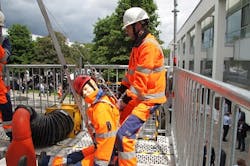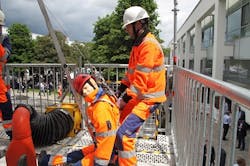German wastewater engineering championship draws international competitors
MUNICH, Germany - Nearly 30 teams from Germany, Egypt, Slovenia, the USA and Austria took up the challenge of the German Association for Water, Wastewater and Waste (DWA) and participated in the third Open German Championship in wastewater engineering at the IFAT event held last week in Germany.
The professional competition for the operating personnel in wastewater treatment plants and the university challenge were held in several disciplines.
Wastewater professionals had to show how they comply with the occupational health and safety requirements when rescuing an injured colleague from a shaft, that they master the maintenance and repair activities based on the example of an underwater motor pump, that they are able to handle measuring and control devices quickly and correctly, and that they can control process operations.
For this purpose, the flow diagram of a water treatment plant had to be created using magnetic cards on a whiteboard, a malfunction had to be identified and remedied.
Meanwhile young academics had to perform tasks on the sustainable use of water resources. The relationship between water use, social and economic development and environmental sustainability had to be simulated, an innovative idea had to be assessed and structural development measures from the areas of water, waste and energy had to be suitably combined.
In addition, the participants had to demonstrate that they have mastered the control and measuring in drains and wastewater treatment plants.
“It’s great to see how much commitment the teams put into their tasks”, said Rüdiger Heidebrecht, head of the DWA department Training and International Relations and the initiator of the competitions. “Whoever takes part is already a winner, whether he’s among the top finishers or not. What counts is the motivation and the team spirit. That’s what the employers like to see.”
Heidebrecht added: “The competition was hard. But that really spurs people on to do their best.”
###
Read more


